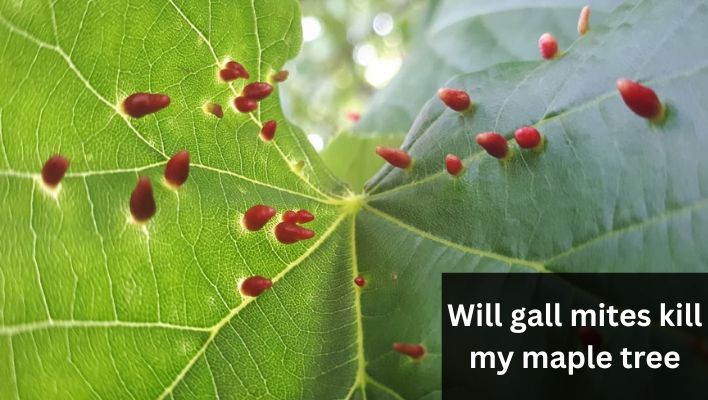Gall mites may be tiny, but their impact on maple trees can be significant. These microscopic pests, belonging to the spider mite family, have a knack for causing trouble. But before we delve deeper into their mischievous ways, let’s take a moment to know if gall mites kill my maple tree.
Gall mites, those minuscule troublemakers, have been known to cause havoc among maple tree enthusiasts. Their microscopic presence can lead to the formation of galls, unsightly growths that mar the tree’s beauty. But the burning question remains: can these pesky mites kill your maple tree?
Maple trees hold a special place in our hearts and landscapes. Their stunning foliage and ability to provide shade and beauty make them a cherished presence. However, their vulnerability to pests, including gall mites, can pose challenges to their health and longevity.
In this article, we will explore the world of gall mites and their relationship with maple trees. We’ll uncover the symptoms of gall mite infestations, evaluate the potential threat they pose to maple trees, and discuss preventive measures to safeguard these cherished giants.
By the end, you’ll be armed with the knowledge to identify and manage gall mite infestations, ensuring the continued health and splendor of your maple tree.
So, without further ado, let’s dive into the intriguing world of gall mites and their impact on our beloved maple trees.
How Gall Mites Affect Maple Trees
Gall mites may be small, but their effects on maple trees can be significant. Understanding how these pests impact our beloved maples is crucial in managing and mitigating their damage. This will explore the intricacies of gall mite infestations and learn to identify the telltale signs on maple trees.
Gall mite infestations occur when these tiny arachnids puncture the leaves, buds, or twigs of the tree, leading to the formation of galls. These abnormal growths are the result of the tree’s response to the mites’ feeding activity. Different species of gall mites can induce a variety of galls, which can be green, red, or brown, depending on the specific mite and tree species involved.
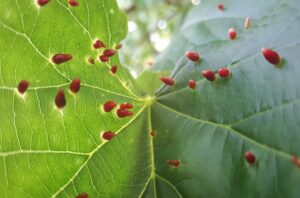
Identifying gall mite symptoms on maple trees is crucial for timely intervention. Some common signs include distorted or discolored leaves, stunted growth, leaf drop, and twig dieback. Upon closer inspection, you may spot the presence of galls on the affected parts of the tree. These galls can vary in size and shape, often resembling small bumps, swellings, or even miniature spheres.
Keep a keen eye on the foliage and overall health of your maple tree. Early detection of gall mite infestations can help prevent further damage and increase the chances of successful management. By learning to identify the symptoms, you empower yourself to take proactive measures to protect your maple tree from the clutches of these tiny but troublesome pests.
Can Gall Mites Kill Maple Trees?
The presence of gall mites on your maple tree may be concerning, but the burning question remains: Can gall mites kill your beloved tree? Let’s delve into this topic and uncover the truth about the potential threat gall mites pose to maple trees.
Gall mites can certainly impact the health of maple trees, but the extent of their damage varies depending on several factors. Severe infestations can lead to defoliation, stunted growth, and an overall decline in the tree’s vitality. However, it’s important to note that gall mites typically do not kill maple trees outright.
The severity of gall mite damage depends on various factors, including the health and age of the tree, the extent of the infestation, and environmental conditions. Young maple trees or those already weakened by stressors like drought or disease may be more susceptible to the detrimental effects of gall mites.
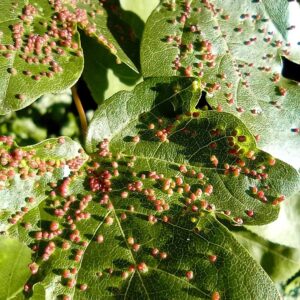
Identifying the symptoms and signs of a severe gall mite infestation is crucial for assessing the level of threat to your maple tree. Look out for widespread defoliation, extensive twig dieback, and a significant decline in overall vigor. If these signs are present, it’s essential to take prompt action to address the infestation and support the tree’s recovery.
While gall mites can cause significant damage, maple trees possess a remarkable ability to recover from such infestations, especially when appropriate measures are taken to manage the problem.
Treating Gall Mite Infestations
Dealing with a gall mite infestation on your maple tree requires prompt action to prevent further damage and promote tree health. Fortunately, there are several effective methods to treat gall mite infestations. Let’s explore these options:
- Pruning and Destroying Affected Branches: During the dormant season, carefully prune and remove branches with galls. Destroy these branches by burning or disposing of them properly. This helps eliminate a significant portion of the gall mite population and prevents the infestation from spreading.
- Horticultural Oils: Horticultural oils, such as neem oil or dormant oil, can be effective in controlling gall mites. These oils suffocate the mites, disrupting their feeding and reproductive activities. Apply the oil according to the product instructions during the appropriate season to achieve maximum effectiveness.
- Beneficial Insects: Introducing predatory insects, such as ladybugs or predatory mites, can help control gall mite populations naturally. These beneficial insects feed on the mites, reducing their numbers and limiting their damage. Consult with a local nursery or an expert to determine the suitable beneficial insects for your area and release them strategically.
- Chemical Control: In severe infestations, chemical control options can be considered. Consult with a professional arborist or horticulturist to determine the appropriate pesticide to use. Follow the instructions carefully and ensure the product is labeled for use on maple trees. Apply the pesticide during the recommended time to minimize any potential harm to beneficial insects and the environment.
- Water Sprays: Using a strong stream of water, spray the affected areas of the tree to dislodge and wash away the gall mites. This method is particularly useful for early-stage infestations or as a preventive measure. Repeat the process regularly to disrupt the mites’ feeding and reproductive cycle.
- Biological Control: Explore the possibility of using biological control agents, such as beneficial nematodes or microbial insecticides, to target gall mites. These agents can help reduce mite populations without harming beneficial insects or the environment. Consult with experts or extension services to determine the suitability and availability of these options.
- Systemic Insecticides: In cases of severe infestations or when other methods haven’t yielded satisfactory results, systemic insecticides can be considered. These insecticides are absorbed by the tree, making them effective against gall mites that feed on the sap. However, exercise caution and follow the instructions carefully to ensure safe and responsible use.
- Cultural Practices: Adopting good cultural practices can help improve tree health and resilience, making them less susceptible to gall mite infestations. These practices include proper pruning to maintain tree structure, regular fertilization to promote vigor, and adequate irrigation to prevent stress.
- Professional Consultation: When dealing with extensive or persistent gall mite infestations, seeking guidance from a professional arborist or horticulturist is highly recommended. They can provide expert advice, diagnose the severity of the infestation, and offer customized solutions based on the specific needs of your maple tree.
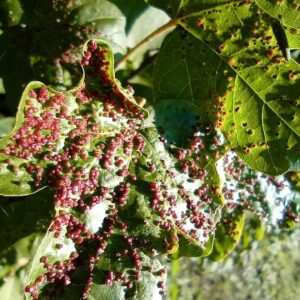
Preventing Gall Mite Infestations
Prevention is always better than cure when it comes to gall mite infestations on maple trees. By implementing proactive measures, you can minimize the risk of these tiny pests causing damage. Let’s explore some effective strategies for preventing gall mite infestations:
- Regular Inspections: Regularly inspect your maple tree, especially during the growing season, for any signs of gall mite activity. Look for distorted leaves, abnormal growths, or discoloration. Early detection allows for timely intervention and reduces the chance of the infestation spreading.
- Proper Tree Care: Maintain good tree health by providing proper care. Ensure your maple tree receives adequate water, nutrients, and sunlight. Healthy, vigorous trees are more resilient to gall mite infestations and can better withstand their damage.
- Pruning and Sanitation: Prune your maple tree to maintain good structure and airflow. Remove dead, damaged, or infested branches promptly. This helps reduce potential hiding places for gall mites and prevents the infestation from spreading to other parts of the tree.
- Mulching: Apply a layer of organic mulch around the base of the tree, avoiding direct contact with the trunk. Mulch helps conserve moisture, regulate soil temperature, and improve overall tree health. It also creates a barrier that discourages gall mites from crawling up the tree.
- Avoid Over-Fertilization: Be cautious with fertilizer application, as over-fertilization can lead to excessive succulent growth, which is attractive to gall mites. Follow recommended guidelines for fertilizing your maple tree and avoid excessive nitrogen-rich fertilizers.
- Diversity in Landscaping: Plant a diverse range of tree species in your landscape. This helps prevent a concentrated infestation of gall mites on a single species, reducing the risk of widespread damage. Diversity also promotes a healthier ecosystem and provides a natural balance against pests.
- Clean Surroundings: Maintain a clean environment around your maple tree. Remove fallen leaves, debris, and weeds regularly. This reduces hiding places for gall mites and other pests, minimizing the risk of infestation.
- Early Intervention: At the first sign of gall mite activity, take immediate action to control the infestation. Early intervention can prevent the mites from establishing a strong foothold and causing extensive damage.
By adopting these preventive measures, you can create an environment that is less favorable for gall mites to thrive and infest your maple tree. Stay vigilant and proactive to ensure the long-term health and beauty of your cherished tree.
Will Gall Mites Kill my Maple Tree FAQs
Can gall mites infest other tree species?
Yes, gall mites can infest a variety of tree species, not just maple trees. Different species of gall mites have specific host preferences, and they may target trees such as oaks, elms, birches, or poplars.
If you have multiple tree species in your yard, it’s important to be vigilant and monitor for gall mite activity on all trees.
Are there specific maple tree varieties more susceptible to gall mites?
While gall mites can infest various maple tree species, some varieties may be more susceptible to infestations than others. Certain cultivars or hybrids may exhibit higher vulnerability due to genetic factors or characteristics that make them more attractive to gall mites.
It’s recommended to research and choose maple tree varieties known for their resistance to gall mite infestations, especially if gall mites are a recurring issue in your area.
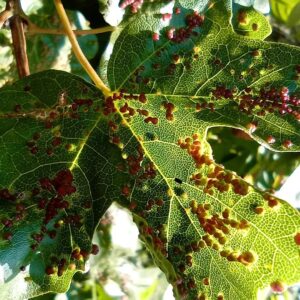
How long does it take for a maple tree to recover from a gall mite infestation?
The recovery time for a maple tree after a gall mite infestation can vary depending on several factors, including the severity of the infestation, the health and age of the tree, and the effectiveness of treatment measures.
In general, if the infestation is addressed early and appropriate treatments are applied, a maple tree can start recovering within a growing season.
However, complete recovery and regrowth may take several years, particularly for trees that have experienced extensive damage. It’s important to provide ongoing care and monitor the tree’s progress to ensure its successful recovery.
Can gall mites spread to other trees in my yard?
Gall mites can spread to other trees within your yard under certain conditions. The mites can be transported by wind, insects, or by accidentally transferring them through pruning tools or equipment.
Additionally, if gall mites have established a population on one tree and it remains untreated, they can potentially move to nearby trees and infest them as well.
Therefore, it’s crucial to address gall mite infestations promptly and take preventive measures to protect other susceptible trees in your yard.
How long does it take for a maple tree to recover from a gall mite infestation?
The recovery time for a maple tree after a gall mite infestation can vary depending on several factors, including the severity of the infestation, the health and age of the tree, and the effectiveness of treatment measures.
In general, if the infestation is addressed early and appropriate treatments are applied, a maple tree can start recovering within a growing season.
However, complete recovery and regrowth may take several years, particularly for trees that have experienced extensive damage. It’s important to provide ongoing care and monitor the tree’s progress to ensure its successful recovery.
Conclusion
Gall mite infestations can pose a threat to the health and vitality of maple trees. These tiny pests can cause distorted growth, leaf damage, and unsightly galls, raising concerns among tree owners.
However, while gall mite infestations can be concerning, they do not typically result in the death of maple trees. It is important to note that while severe infestations can weaken the tree, with appropriate care and intervention, most maple trees can recover and continue to thrive.
By understanding the nature of gall mites, and their impact on maple trees, and implementing effective management strategies, tree owners can protect their beloved maples and promote their long-term health.
Remember, early detection, prompt action, and ongoing care are key to mitigating the effects of gall mite infestations and ensuring the resilience of your maple trees for years to come.
